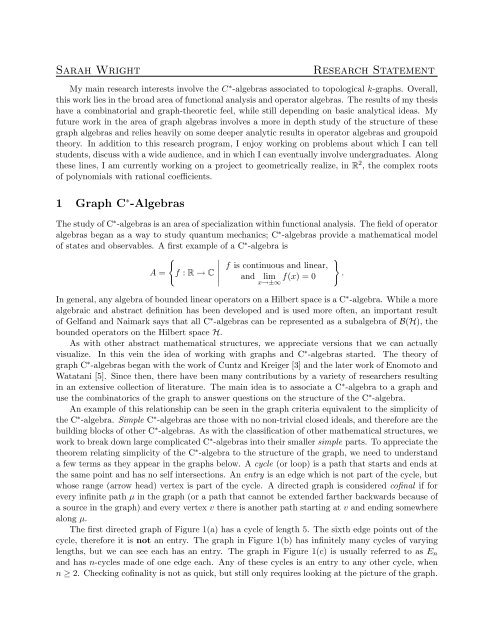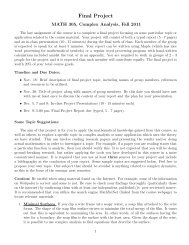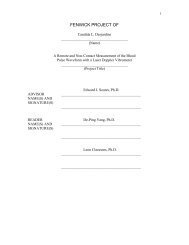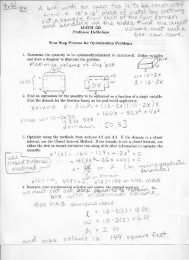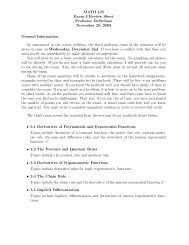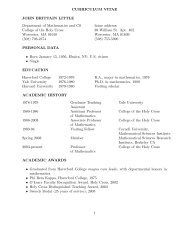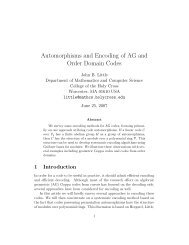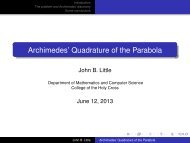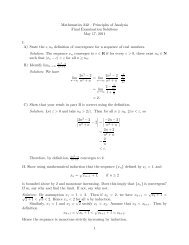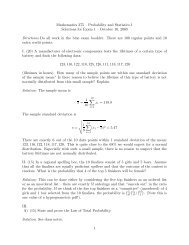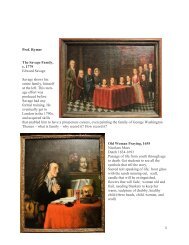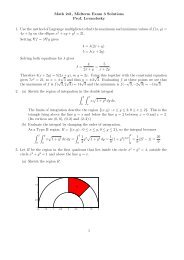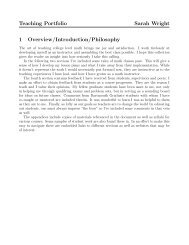Research Statement - Mathematics and Computer Science
Research Statement - Mathematics and Computer Science
Research Statement - Mathematics and Computer Science
Create successful ePaper yourself
Turn your PDF publications into a flip-book with our unique Google optimized e-Paper software.
Sarah Wright <strong>Research</strong> <strong>Statement</strong><br />
My main research interests involve the C ∗ -algebras associated to topological k-graphs. Overall,<br />
this work lies in the broad area of functional analysis <strong>and</strong> operator algebras. The results of my thesis<br />
have a combinatorial <strong>and</strong> graph-theoretic feel, while still depending on basic analytical ideas. My<br />
future work in the area of graph algebras involves a more in depth study of the structure of these<br />
graph algebras <strong>and</strong> relies heavily on some deeper analytic results in operator algebras <strong>and</strong> groupoid<br />
theory. In addition to this research program, I enjoy working on problems about which I can tell<br />
students, discuss with a wide audience, <strong>and</strong> in which I can eventually involve undergraduates. Along<br />
these lines, I am currently working on a project to geometrically realize, in R 2 , the complex roots<br />
of polynomials with rational coefficients.<br />
1 Graph C ∗ -Algebras<br />
The study of C ∗ -algebras is an area of specialization within functional analysis. The field of operator<br />
algebras began as a way to study quantum mechanics; C ∗ -algebras provide a mathematical model<br />
of states <strong>and</strong> observables. A first example of a C∗-algebra is<br />
<br />
<br />
<br />
A = f : R → C <br />
<br />
f is continuous <strong>and</strong> linear,<br />
<strong>and</strong> lim f(x) = 0<br />
x→±∞<br />
<br />
.<br />
In general, any algebra of bounded linear operators on a Hilbert space is a C ∗ -algebra. While a more<br />
algebraic <strong>and</strong> abstract definition has been developed <strong>and</strong> is used more often, an important result<br />
of Gelf<strong>and</strong> <strong>and</strong> Naimark says that all C ∗ -algebras can be represented as a subalgebra of B(H), the<br />
bounded operators on the Hilbert space H.<br />
As with other abstract mathematical structures, we appreciate versions that we can actually<br />
visualize. In this vein the idea of working with graphs <strong>and</strong> C ∗ -algebras started. The theory of<br />
graph C ∗ -algebras began with the work of Cuntz <strong>and</strong> Kreiger [3] <strong>and</strong> the later work of Enomoto <strong>and</strong><br />
Watatani [5]. Since then, there have been many contributions by a variety of researchers resulting<br />
in an extensive collection of literature. The main idea is to associate a C ∗ -algebra to a graph <strong>and</strong><br />
use the combinatorics of the graph to answer questions on the structure of the C ∗ -algebra.<br />
An example of this relationship can be seen in the graph criteria equivalent to the simplicity of<br />
the C ∗ -algebra. Simple C ∗ -algebras are those with no non-trivial closed ideals, <strong>and</strong> therefore are the<br />
building blocks of other C ∗ -algebras. As with the classification of other mathematical structures, we<br />
work to break down large complicated C ∗ -algebras into their smaller simple parts. To appreciate the<br />
theorem relating simplicity of the C ∗ -algebra to the structure of the graph, we need to underst<strong>and</strong><br />
a few terms as they appear in the graphs below. A cycle (or loop) is a path that starts <strong>and</strong> ends at<br />
the same point <strong>and</strong> has no self intersections. An entry is an edge which is not part of the cycle, but<br />
whose range (arrow head) vertex is part of the cycle. A directed graph is considered cofinal if for<br />
every infinite path µ in the graph (or a path that cannot be extended farther backwards because of<br />
a source in the graph) <strong>and</strong> every vertex v there is another path starting at v <strong>and</strong> ending somewhere<br />
along µ.<br />
The first directed graph of Figure 1(a) has a cycle of length 5. The sixth edge points out of the<br />
cycle, therefore it is not an entry. The graph in Figure 1(b) has infinitely many cycles of varying<br />
lengths, but we can see each has an entry. The graph in Figure 1(c) is usually referred to as En<br />
<strong>and</strong> has n-cycles made of one edge each. Any of these cycles is an entry to any other cycle, when<br />
n ≥ 2. Checking cofinality is not as quick, but still only requires looking at the picture of the graph.
Sarah Wright - <strong>Research</strong> <strong>Statement</strong> 2<br />
In Figure 1(b), we can see that there is a path from vm to vn if m > n <strong>and</strong> a path from v1 to any<br />
other vertex. These two observations together give a path from any vertex to any other vertex, so<br />
the graph is cofinal.<br />
v1<br />
v2<br />
(a) Cycle Without Entry<br />
(b) A cofinal graph<br />
(c) The Graph En<br />
Figure 1: Three Examples of Directed Graphs<br />
The existence of entries for each cycle <strong>and</strong> the cofinality of the graph relate to the structure of the<br />
C ∗ -algebra by the following theorem of Kumjian, Pask, Raeburn, <strong>and</strong> Renault. The requirement<br />
of a graph to be row-finite (each vertex receives only finitely many edges) was later dealt with by<br />
Drinen <strong>and</strong> Tomforde yielding a similar theorem in [4].<br />
Theorem. [15, Theorem 4.14] Suppose E is a row-finite graph in which every cycle has an entry.<br />
Then C ∗ (E) is simple if <strong>and</strong> only if E is cofinal.<br />
In particular, this theorem tells us the C ∗ -algebra associated to the graph En, Figure 1(c), which is<br />
the Cuntz algebra On, is simple when n ≥ 2. As the Cuntz Algebra is well-studied, its simplicity is<br />
not new upon the proof of this theorem, but the ease with which the theorem is applied demonstrates<br />
its importance <strong>and</strong> beauty. There are further theorems in the field that give a description of the<br />
ideal structure of a graph-algebra, see [2, 8]. Similar to the theorem above, the results give a way<br />
to nearly “read-off” the ideal structure of the algebra from properties of the graph.<br />
The study of graph algebras had been particularly fruitful in its provision of a rich class of easily<br />
accessible examples of C ∗ -algebras with various properties. To this end, the idea of a graph has been<br />
generalized in many ways to provide even more examples. The long list of generalizations includes<br />
the labeled graphs of Bates <strong>and</strong> Pask where edges of the graph are labelled from an alphabet set, the<br />
k-graphs of Kumjian <strong>and</strong> Pask, where rather than paths of length ℓ ∈ N we work with k-dimensional<br />
paths of shape n ∈ N k , <strong>and</strong> the topological graphs of Katsura, where instead of discrete sets of<br />
vertices <strong>and</strong> edges we give these spaces interesting topologies. For definitions of these structures see<br />
[1], [12], <strong>and</strong> [11] respectively. Most recently the work of Yeend provides a generalization of both<br />
higher-rank graphs <strong>and</strong> topological graphs, with the unifying theory of topological k-graphs [21].<br />
2 Aperiodicity Conditions <strong>and</strong> Related Results<br />
The importance of cycles having or not having entries is the idea of being able to “back out of a<br />
cycle” <strong>and</strong> build an aperiodic infinite path. (The convention to construct paths backward comes<br />
from the methods used to construct the associated C ∗ -algebra.) The relationship between the<br />
periodic paths (or lack there of) in the graph <strong>and</strong> the simplicity of the associated C ∗ -algebra is<br />
an important result for all types of graphs. The C ∗ -algebras of directed graphs, k-graphs, <strong>and</strong><br />
topological k-graphs were all originally constructed using groupoid methods (a well-studied method<br />
of constructing a C ∗ -algebra that generalizes the algebra generated by a group). More elementary<br />
methods for construction have been established since these initial works. As the infinite paths of<br />
the graph play such a central role in the groupoid construction of the C ∗ -algebra, in the case of<br />
higher-rank graphs, the original aperiodicity condition, called Condition (A), was stated in terms<br />
v3<br />
v4<br />
v5<br />
v6<br />
en<br />
.<br />
e3<br />
e2<br />
e1<br />
v
Sarah Wright - <strong>Research</strong> <strong>Statement</strong> 3<br />
of these infinite paths [12]. Lewin, Robertson, <strong>and</strong> Sims have developed equivalent conditions to<br />
aperiodicity [18, 13] that have proven easier to verify in concrete examples <strong>and</strong> more useful tools in<br />
proofs. In the following theorem, I extend these results to topological k-graphs.<br />
Theorem. [20, Theorem 3.1] Let (Λ, d) be a compactly aligned topological k-graph with no sources.<br />
Then the following conditions are equivalent.<br />
(A) For any open set V ⊂ Λ 0 there exists an aperiodic path x ∈ V ∂Λ.<br />
(B) For any open set V ⊂ Λ 0 <strong>and</strong> any pair m = n ∈ N k there exists a path λV,m,n ∈ V Λ such that<br />
d(λ) ≥ m ∨ n <strong>and</strong><br />
λ(m, m + d(λ) − (m ∨ n)) = λ(n, n + d(λ) − (m ∨ n)). (⋆)<br />
(C) For any distinct pair of open sets X, Y ⊂ Λ such that s(X) = s(Y ) <strong>and</strong> both s|X <strong>and</strong> s|Y are<br />
homeomorphisms there exists τ ∈ s(X)Λ such that MCE(Xτ, Y τ) = ∅.<br />
Condition (A) is Yeend’s aperiodicity condition concerning infinite paths. The second condition<br />
deals with specific sections of finite paths. In a directed graph it would require that for any vertex<br />
v <strong>and</strong> any m = n ∈ N we could find a path ending at v where the m th <strong>and</strong> n th edges are distinct.<br />
Condition (C) deals with the possibility of extending distinct paths such that they are equivalent.<br />
Considering each condition of the above theorem in the discrete k-graph case, we derive a corollary<br />
giving the equivalence of Kumjian <strong>and</strong> Pask’s [12], Robinson <strong>and</strong> Sims’ [18], <strong>and</strong> Lewin <strong>and</strong> Sims’<br />
[13] definitions of aperiodicity. This is a previously known fact, but reducing the proof of the theorem<br />
gives a direct proof, which is a nice (<strong>and</strong> new) result.<br />
To demonstrate the importance of these formulations of aperiodicity I have constructed a new<br />
class of examples of topological k-graphs, which I call twisted product topological k-graphs.<br />
α 1 0<br />
α 2 α<br />
0<br />
2 1<br />
α 3 α<br />
0<br />
3 α<br />
1<br />
3 2<br />
v0 v1 v2 v3<br />
β 1 0 β 2 0<br />
β 2 β<br />
1<br />
3 0<br />
β 3 1<br />
β 3 2<br />
· · · · · ·<br />
vn<br />
α n n-1<br />
.<br />
α n α<br />
0<br />
n 1<br />
β n 0<br />
β n 1<br />
.<br />
β n n-1<br />
vn+1<br />
Figure 2: We visualize k-graphs by drawing<br />
their 1-skeletons. The vertices are those of<br />
the k-graph, the edges are the paths of the kgraph<br />
of shape ei ∈ N k which are colored in kdifferent<br />
colors to show their shape. To know<br />
the entire structure of the k-graph we also need<br />
to give factorization rules. See [15, 16].<br />
The idea is to start with a discrete k-graph Λ <strong>and</strong> a topological space X. We replace each vertex in<br />
Λ with a copy of X <strong>and</strong> twist the sources of the edges according to a continuous functor τ. Starting<br />
with the k-graph whose 1-skeleton is pictured in Figure 2, replacing the vertices with a copy of<br />
the circle T, <strong>and</strong> twisting the edges by a factor of n in the n th grouping gives <strong>and</strong> example of a<br />
topological 2-graph in which Condition (C) is fairly straightforward to check, where Condition (A) is<br />
nearly impossible [20]. The previous example demonstrates the benefits of Condition (C) in checking<br />
aperiodicity for a particular topological k-graph, but it is also useful condition in proving other more<br />
general results. In [17], the authors use Condition (C) in the proof of a Cuntz-Krieger Uniqueness<br />
Theorem for topological k-graphs.<br />
3 On-Going <strong>and</strong> Current Work<br />
3.1 Aperiodicity <strong>and</strong> Twisted Product Graphs<br />
It is worth noting that my work in [20] covers only topological k-graphs without sources. This was a<br />
condition required in the early work on directed graphs, topological graphs, <strong>and</strong> k-graphs alike that
Sarah Wright - <strong>Research</strong> <strong>Statement</strong> 4<br />
was eventually replaced with less restrictive hypotheses. I am currently working to develop similar<br />
conditions <strong>and</strong> results for topological k-graphs with sources.<br />
Many interesting questions arise out of the development of these twisted topological k-graphs.<br />
The first <strong>and</strong> (I feel) most obvious question to ask is, “What structural similarities does C ∗ (Λ×τ X)<br />
inherit from the discrete k-graph (Λ, d)?” In his thesis work developing the basic theory of topological<br />
k-graphs, Yeend defines <strong>and</strong> describes similar constructions for constructing new topological graphs<br />
from old ones. He is able to show specific properties of the graph <strong>and</strong> the associated C ∗ -algebra<br />
that are retained through these constructions.<br />
I am particularly interested in the levels of aperiodicity that are retained or lost in this twisted<br />
product. Can we start with a periodic discrete k-graph <strong>and</strong> twist it in a particular way to make<br />
it aperiodic? Can the reverse be done? The fact that Conditions (B) <strong>and</strong> (C) of the theorem<br />
above reduce aperiodicity to a question of finite paths rather than infinite makes the questions of<br />
aperiodicity in the twisted product graphs easier to answer.<br />
3.2 Labeled Higher-Rank Graphs<br />
Yeend combined two previously studied generalizations of graphs to define topological k-graphs.<br />
Beyond the fact that this provides one unifying theory of the two fields, it also provides researchers<br />
with an even larger class of C ∗ -algebras that can be visualized. The work of Bates <strong>and</strong> Pask on<br />
labeled graphs <strong>and</strong> their associated C ∗ -algebras simultaneously generalize the ultragraph algebras<br />
of Tomforde [19] <strong>and</strong> the shift space C ∗ -algebras of Matsumoto [14]. Currently, there is no work<br />
that combines labeled graphs with higher-rank graphs. The work of [7] gives fundamental results<br />
concerning the structure of the 1-skeleton <strong>and</strong> set of commuting squares of a higher-rank graph.<br />
This gives a set of objects generalizing the edge set of a directed graph, that we can label with an<br />
alphabet set. At the most recent Great Plains Operator Theory Conference in Houston, Sam Webster<br />
presented the results of [7], <strong>and</strong> Paulette Willis <strong>and</strong> I started began considering <strong>and</strong> discussing the<br />
idea of labeling higher-rank graphs. I am currently starting work with Pask, Webster <strong>and</strong> Willis to<br />
formalize these results into a theory of labeled k-graph algebras.<br />
3.3 The Structure of the Primitive Ideal Space<br />
At the same GPOTS conference in June, Sooran Kang presented her work with David Pask on the<br />
primitive ideal space of a row-finite k-graph [10]. A member of the audience asked if she could say<br />
when this space was Hausdorff. She was not able to give an answer to this question, but pointed<br />
out that there was a similar open question in the field of directed graph-algebras. Geoff Goehle,<br />
has results answering such questions on groupoid C ∗ -algebras. As graph-algebras were originally<br />
constructed using a groupoid model, it is reasonable to think we have almost everything we needed<br />
to answer these questions for graph-algebras of various types. Using the work of Goehle, Clark,<br />
<strong>and</strong> Williams, we are working to translate groupoid C ∗ -algebra results into conditions on the graph,<br />
whether it be a directed graph, k-graph, or a structure even more general.<br />
3.4 Complex Roots of Polynomials<br />
An idea any calculus student can underst<strong>and</strong> is that we can know the real roots of a polynomial<br />
function or solutions to a polynomial equation by seeing where the graph of the function crosses<br />
the x-axis. But, what about those roots that are not real? Are there geometric or graphical<br />
interpretations of imaginary <strong>and</strong> complex roots?
Sarah Wright - <strong>Research</strong> <strong>Statement</strong> <br />
5 <br />
<br />
<br />
<br />
<br />
<br />
<br />
<br />
<br />
<br />
<br />
<br />
<br />
<br />
<br />
It turns out the answer to that is also yes. The work of Gehman<br />
[6] <strong>and</strong> Irwin <strong>and</strong> Wright [9] deal with constructions of complex roots<br />
of polynomials of various degrees. For example, the cubic of Figure 3<br />
has one real root at R, but we know from the Fundamental Theorem<br />
of Algebra that there must be two more. The line in Figure 3 is<br />
constructed to intersect the real root at R <strong>and</strong> be tangent to the curve<br />
at the point T . We call the slope of this tangent line β <strong>and</strong> let α be<br />
Figure 3: A cubic polyno-<br />
the abscissa of the point T , then the work of Irwin <strong>and</strong> Wright states<br />
mial<br />
that the two complex roots of the cubic are α ± βi.<br />
While the work of those mentioned above does cover some higher degree polynomials, we are<br />
not able to find results that cover polynomials with no real roots. Mitsuo Kobayashi (a graduate<br />
school <strong>and</strong> Project NExT colleague of mine) <strong>and</strong> I are hoping to further generalize some of these<br />
results to higher degree polynomials, <strong>and</strong> to those with only complex roots. Both of our research<br />
areas (he works in analytic number theory) depend on basic complex analysis, but this has never<br />
been the focus of either of our work. We are motivated by our love of talking to everyone about<br />
mathematics as well as the enjoyment we get from listening to our students ideas about solving new<br />
problems. We hope to have results soon <strong>and</strong> present them not only as generalizations of the results<br />
of Gehman, Irwin, <strong>and</strong> Wright, but as a next step in the classical constructions of Greek geometry<br />
where one is only allowed a compass <strong>and</strong> straight edge. If we allow graphs <br />
of polynomials <br />
it is easy <br />
to construct the cube root of two, for example. If we also allow the use of <br />
a protractor to measure <br />
slope, what class of numbers can we add to the list of constructible numbers? We hope <br />
not only to <br />
determine these complex roots, but also investigate the minimal tools needed <br />
to construct them.<br />
<br />
<br />
References<br />
<br />
<br />
[1] Teresa Bates <strong>and</strong> David Pask, C<br />
<br />
∗-algebras of labeled graphs, J. Operator Theory 57 (2007),<br />
no. 1, 207–226.<br />
[2] Teresa Bates, David Pask, Iain Raeburn, <strong>and</strong> Wojciech Szymański, The <br />
C <br />
<br />
<br />
<br />
<br />
<br />
<br />
<br />
<br />
<br />
<br />
<br />
<br />
<br />
<br />
<br />
∗-algebras of row-finite<br />
graphs, New York J. Math. 6 (2000), 307–324 (electronic). MR MR1777234 (2001k:46084)<br />
[3] Joachim Cuntz <strong>and</strong> Wolfgang Krieger, A class of C∗-algebras <strong>and</strong> topological Markov chains,<br />
Invent. Math. 56 (1980), no. 3, 251–268. MR MR561974 (82f:46073a)<br />
[4] D. Drinen <strong>and</strong> M. Tomforde, The C∗-algebras of arbitrary graphs, Rocky Mountain J. Math.<br />
35 (2005), no. 1, 105–135. MR MR2117597 (2006h:46051)<br />
[5] Masatoshi Enomoto <strong>and</strong> Yasuo Watatani, A graph theory for C∗-algebras, Math. Japon. 25<br />
(1980), no. 4, 435–442. MR MR594544 (83d:46069a)<br />
[6] H. M. Gehman, Complex roots of a polynomial equation, American Mathematical Monthly 28<br />
(1941), no. 4, 237–239.<br />
[7] Robert Hazlewood, Iain Raeburn, Aidan Sims, <strong>and</strong> Samuel B.G. Webster, On some fundamental<br />
results about higher-rank graphs <strong>and</strong> their C∗-algebras, preprint, arXiv:1110.2269v1.<br />
[8] Jeong Hee Hong <strong>and</strong> Wojciech Szymański, The primitive ideal space of the C∗-algebras of<br />
infinite graphs, J. Math. Soc. Japan 56 (2004), no. 1, 45–64. MR 2023453 (2004j:46088)
Sarah Wright - <strong>Research</strong> <strong>Statement</strong> 6<br />
[9] Frank Irwin <strong>and</strong> Wright H. N., Some properties of polynomial curves, The Annals of <strong>Mathematics</strong><br />
19 (1917), no. 2, 152–158.<br />
[10] Sooran Kang <strong>and</strong> David Pask, Aperiodicity <strong>and</strong> the primitive ideal space of a row-finite k-graph<br />
C ∗ -algebra, preprint, arXiv:1105.1208v2.<br />
[11] Takeshi Katsura, A class of C ∗ -algebras generalizing both graph algebras <strong>and</strong> homeomorphism<br />
C ∗ -algebras. I. Fundamental results, Trans. Amer. Math. Soc. 356 (2004), no. 11, 4287–4322<br />
(electronic).<br />
[12] Alex Kumjian <strong>and</strong> David Pask, Higher rank graph C ∗ -algebras, New York J. Math. 6 (2000),<br />
1–20 (electronic). MR MR1745529 (2001b:46102)<br />
[13] Peter Lewin <strong>and</strong> Aidan Sims, Aperiodicity <strong>and</strong> cofinality for finitely aligned higher-rank graphs,<br />
Math. Proc. Cambridge Philos. Soc. 149 (2010), no. 2, 333–350. MR 2670219<br />
[14] Kengo Matsumoto, On C ∗ -algebras associated with subshifts, Internat. J. Math. 8 (1997), no. 3,<br />
357–374. MR 1454478 (98h:46077)<br />
[15] Iain Raeburn, Graph algebras, CBMS Regional Conference Series in <strong>Mathematics</strong>, vol. 103,<br />
Published for the Conference Board of the Mathematical <strong>Science</strong>s, Washington, DC, 2005. MR<br />
MR2135030 (2005k:46141)<br />
[16] Iain Raeburn, Aidan Sims, <strong>and</strong> Trent Yeend, Higher-rank graphs <strong>and</strong> their C ∗ -algebras, Proc.<br />
Edinb. Math. Soc. (2) 46 (2003), no. 1, 99–115. MR MR1961175 (2004f:46068)<br />
[17] Jean Ranault, Aidan Sims, Dana P. Williams, <strong>and</strong> Trent Yeend, Uniqueness theorems for<br />
topological higher-rank graph C ∗ -algebras, preprint.<br />
[18] David I. Robertson <strong>and</strong> Aidan Sims, Simplicity of C ∗ -algebras associated to higher-rank graphs,<br />
Bull. Lond. Math. Soc. 39 (2007), no. 2, 337–344. MR MR2323468 (2008g:46099)<br />
[19] Mark Tomforde, A unified approach to Exel-Laca algebras <strong>and</strong> C ∗ -algebras associated to graphs,<br />
J. Operator Theory 50 (2003), no. 2, 345–368. MR 2050134 (2005b:46128)<br />
[20] Sarah Wright, Aperiodicity conditions in topological k-graphs, J. Operator Theory, to appear.<br />
[21] Trent Yeend, Topological higher-rank graphs, their groupoids <strong>and</strong> operator algebras, Ph.D. thesis,<br />
March 2005.


